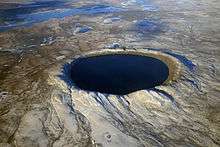Strewn field
The term strewn field indicates the area where meteorites from a single fall are dispersed.[1] It is also often used for the area containing tektites produced by large meteorite impact.[2]

Example of meteorite strewnfield: distribution ellipse of Pultusk meteorite
Formation
There are two strewnfield formation mechanisms:
- Mid-air fragmentation: when a large meteoroid enters the atmosphere it often fragments into many pieces before touching the ground due to thermal shock. This mid-air explosion disperses material over a large oval-shaped area. The long axis of this oval is along the flight path of the meteoroid. When multiple-explosions occur, the material can be found in several overlapping ovals.
- Impact fragmentation: when there is almost no mid-air fragmentation the fragmentation can occur upon impact. In this case the strewnfield shape can be different, usually circular. (e.g. Canyon Diablo at Meteor Crater; Australasian strewnfield)
Fragments distribution
In the case of mid-air fragmentation, smaller fragments tend to fall shorter and the biggest fragments are usually found at the far end of the oval. In order to get an idea of the original flight direction it is necessary to analyze the size pattern of the material over the strewnfield. Fragments of about 1 to 5 grams can be picked up on weather radar as they fall at terminal velocity.
gollark: I'm deploying countercountermeasures.
gollark: Please give me the user ID of the dots and boxes bot.
gollark: <@!293066066605768714> Are you on the d.py server?
gollark: Oh, helloboi MUD? Sure.
gollark: I will get it.
See also
References
- Introduction to Planetary Science: The Geological Perspective. Gunter Faure, Teresa M. Mensing. Springer, 2007. page 118
- Tektites in the geological record: showers of glass from the sky. Gerald Joseph Home McCall. Geological Society of London, 2001. page 10
This article is issued from Wikipedia. The text is licensed under Creative Commons - Attribution - Sharealike. Additional terms may apply for the media files.

